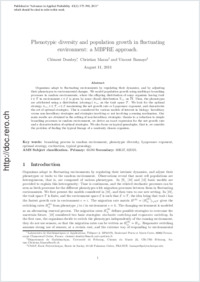Phenotypic diversity and population growth in a fluctuating environment
- Dombry, Clément Laboratoire de Mathématiques, Université de Poitier, France
- Mazza, Christian Département de Mathématiques, Université de Fribourg, Suisse
- Bansaye, Vincent CMAP, Ecole polytechnique, Palaiseau, France
-
17.01.2011
Published in:
- Advances in Applied Probability. - 2011, vol. 43, no. 2, p. 375-398
Branching process in a random environment
phenotypic diversity
Lyapounov exponent
optimal strategy
extinction
typical genealogy
English
Organisms adapt to fluctuating environments by regulating their dynamics, and by adjusting their phenotypes to environmental changes. We model population growth using multitype branching processes in random environments, where the offspring distribution of some organism having trait t ∈ T in environment e ∈ E is given by some (fixed) distribution Yt,e on N. Then, the phenotypes are attributed using a distribution (strategy) πt,e on the trait space T. We look for the optimal strategy πt,e, t ∈ T, e ∈ E, maximizing the net growth rate or Lyapounov exponent, and characterize the set of optimal strategies. This is considered for various models of interest in biology: hereditary versus nonhereditary strategies and strategies involving or not involving a sensing mechanism. Our main results are obtained in the setting of nonhereditary strategies: thanks to a reduction to simple branching processes in a random environment, we derive an exact expression for the net growth rate and a characterization of optimal strategies. We also focus on typical genealogies, that is, we consider the problem of finding the typical lineage of a randomly chosen organism.
- Faculty
- Faculté des sciences et de médecine
- Department
- Département de Mathématiques
- Language
-
- English
- Classification
- Mathematics
- Other electronic version
- License
- License undefined
- Identifiers
-
- RERO DOC 27109
- Persistent URL
- https://folia.unifr.ch/unifr/documents/302003
Statistics
Document views: 91
File downloads:
- maz_pdp.pdf: 131
